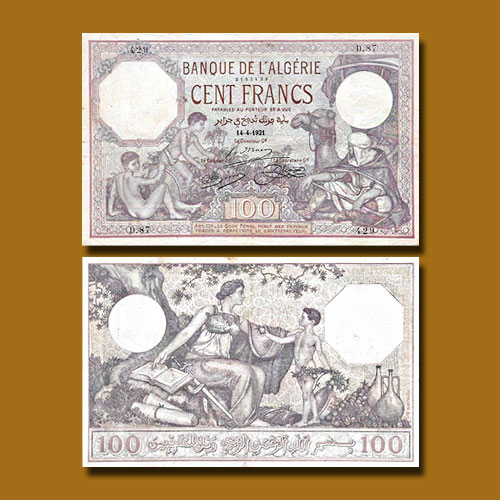Algeria 100 Francs banknote of 1921-1938
2019-12-03 Tue
Algeria is a North African country with a Mediterranean coastline and a Saharan desert interior. The capital and most populous city is Algiers, located in the far north of the country. The country is a semi-presidential republic consisting of 48 provinces and 1,541 communes (counties).With the 16th largest oil reserves in the world, the second largest in Africa and the 9th largest reserves of natural gas, Algeria supplies large amounts of natural gas to Europe, and energy exports are the backbone of the economy.
Algeria is classified as an upper middle income country by the World Bank. Though Algeria's current currency is the Dinar, the franc was the currency of Algeria between 1848 and 1964. It was subdivided into 100 centimes.
The Banque d'Algérie introduced its first notes in 1861. Denominations of 5, 10, 50, 100, 500 and 1000 francs were introduced by 1873 although the 10-franc note was issued only in 1871. Today we are discussing a 100 Francs banknote of Algeria issued from 1921 to 1938. The note specifications are as follows:
The obverse depicts children harvesters to left and an Arab man with a camel to right. The reverse depicts a beautiful painting were a harvester boy is seen giving fruit to a woman, who holds him by his shoulder, they are surrounded by tree, book, sword, two pitchers, and pile of fruit. This pale brown note has an Algerian woman in traditional dress and Arab script above a crescent moon as its watermark.
Image Courtesy: Banknote Museum
Latest News
-
Malwa Sultan Mahmud Shah Silver Coins
2025-09-11 ThuMalwa Sultan Mahmud Shah minted silver coins in round and square flans. <br><br> For round coins,...
-
Malwa Sultan Mahmud Shah Billon coin
2025-08-26 TueMalwa Sultan Mahmud Shah's billon coins followed three weight standards: 100 rati, 96 rati, and 80 r...
-
Fascinating Archaeological Facts on Postage Stamps - 91
2025-08-23 SatRhinoceros is one of the oldest land mammal species existing in India. There are five species of rhi...
-
Fascinating Archaeological Facts on Postage Stamps - 90
2025-08-23 SatUthiramerur, a Village in Kanchipuram, Tamil Nadu, is notable for its Temple inscriptions that descr...
-
Fascinating Archaeological Facts on Postage Stamps - 89
2025-08-21 ThuThe term “millet” is derived from the Latin word “milum,” which translates to grain. millets...

